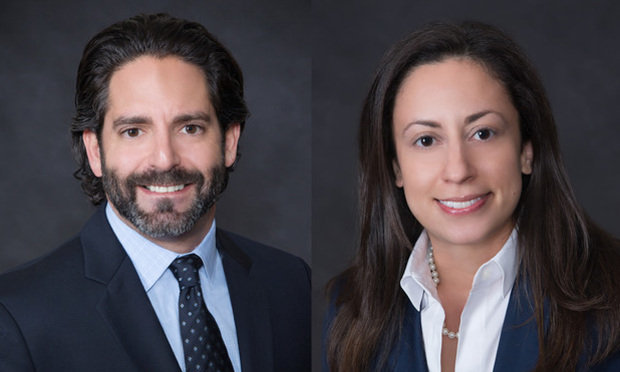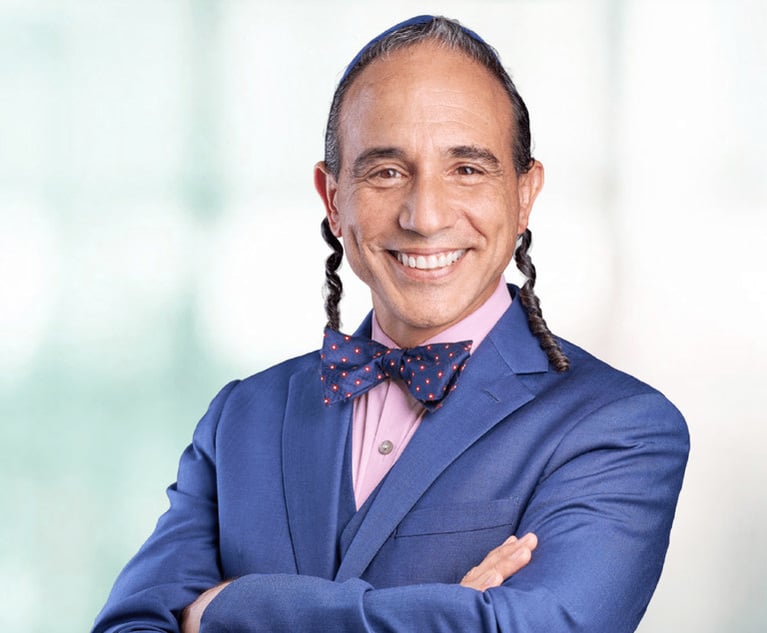Statute of Repose for Latent Construction Defects Extension Creates Increased Risk
On March 23, Gov. Rick Scott approved House Bill 875, which amended Florida Statute Section 95.11(3)(c) by extending the Statute of Repose (the ultimate deadline to assert claims) for latent construction defect claims.
September 24, 2018 at 10:08 AM
5 minute read
 Adam P. Handfinger, Miami co-managing partner, left, and Nathalie Vergoulias, right, associate with Peckar & Abramson, in Miami.
Adam P. Handfinger, Miami co-managing partner, left, and Nathalie Vergoulias, right, associate with Peckar & Abramson, in Miami.
On March 23, Gov. Rick Scott approved House Bill 875, which amended Florida Statute Section 95.11(3)(c) by extending the Statute of Repose (the ultimate deadline to assert claims) for latent construction defect claims. Prior to the amended language, the Statute of Repose was 10 years following project completion, but the revised statutory language extends this period and states as follows: “However, counterclaims, cross-claims, and third-party claims that arise out of the conduct, transaction, or occurrence set out or attempted to be set out in a pleading may be commenced up to one year after the pleading to which such claims relate is served, even if such claims would otherwise be time barred.” This extension presents significantly increased risk for the entire development, construction and real estate industries, and should result in significantly higher insurance premiums.
From an initial reading of the amended language, it is clear that the previous 10-year deadline to file suit for latent construction defects has now been extended by at least one year, in the event that a pleading to which claims for latent defects relate is served just prior to the expiration of the original period. But, if you consider the reality of most complex claims for construction defects, the amended language actually extends the period to file suit by a longer period of time. The following example illustrates how this could work.
A condominium association files its lawsuit against the developer for latent defects just before the expiration of 10 years after the date of the issuance of the certificate of occupancy, and the previous 10-year Statute of Repose. The developer now has an additional one year to file suit against the potentially culpable contractor and design professionals, even though almost 11 years would have passed since the issuance of the certificate of occupancy. And, just before the expiration of an additional one-year period (almost 12 years after final completion), the contractor and design professionals can now sue potentially culpable subcontractors. Those newly joined subcontractors, then have an additional one-year period to assert claims against potentially culpable sub-subcontractors, suppliers and design consultants, and so on, and so on, creating a scenario where claims for latent construction defects are first being asserted 13 years (and perhaps longer) after final completion. While this was likely not the intent of the drafters, the language makes this a potential, and perhaps likely, scenario.
The increase in time upon which claims can be asserted for latent construction defects is, in and of itself, a significant increased risk that must be addressed in all construction contracts, including prime contracts and subcontract agreements. In addition, many insurance policies will not provide coverage beyond the 10-year Statute of Repose, which creates a much bigger problem and potential industry crisis.
For those construction projects insured under traditional procurement programs (where the contractor and subcontractors each procure their own general liability policy and the subcontractors name the general contractor and developer, and perhaps others, as additional insureds), contractors must make sure the contractual obligation to maintain completed operations additional insured coverage extends through the 10-year Statute of Repose and any extension thereof as a result of the amended language. Contract documents (particularly subcontracts) should be reviewed and potentially amended to ensure the extended period is covered, and contractors must train their personnel to track their subcontractor's policies to confirm that completed operations additional insured coverage is provided beyond the previous 10-year Statute of Repose, but based on the above example it is not clear how long the coverage must be maintained. (The amendment creates similar uncertainty relative to the length of time to maintain project files as 10 years are no longer sufficient.)
The problem is even more significant for those projects insured under an owner controlled insurance program or contractor controlled insurance program, commonly known as wrap policies, where almost all project participants obtain general liability and other coverage under the same policy. These types of policies are generally not renewed annually, and the post-completion tail coverage (previously 10 years) is defined and purchased up front and before commencement of construction. While the language of wrap policies varies among the carriers issuing same and projects, many only provide completed operations coverage for “10 years, or the applicable statute of repose, whichever is less.” It is very rare (if not impossible) to find a Wrap Policy that provides completed operations coverage for “10 years, or the applicable statute of repose, whichever is greater.” Unless the insurance market begins to provide more expansive coverage, this could leave all contractors and subcontractors on any particular project uninsured after the expiration of 10 years following final completion.
The potential expiration in coverage requires owners (including condominium associations), as well as implicated contractors and subcontractors, to assert their claims and work to ensure that all potentially culpable parties are joined in the litigation as early as possible. Insurance coverage is obviously an important tool to resolve and settle construction defect claims, so everyone has an interest in making sure it is available.
Those potentially impacted by this statutory revision should consult their counsel to understand all impacts of the statutory amendment.
Adam P. Handfinger is the Miami co-managing partner at the national construction law firm of Peckar & Abramson.
Nathalie Vergoulias is an associate in the firm's Miami office.
This content has been archived. It is available through our partners, LexisNexis® and Bloomberg Law.
To view this content, please continue to their sites.
Not a Lexis Subscriber?
Subscribe Now
Not a Bloomberg Law Subscriber?
Subscribe Now
NOT FOR REPRINT
© 2025 ALM Global, LLC, All Rights Reserved. Request academic re-use from www.copyright.com. All other uses, submit a request to [email protected]. For more information visit Asset & Logo Licensing.
You Might Like
View All
Turning the Shock of a January Marital Split Into Effective Strategies for Your Well-Being
5 minute read

Trending Issues in Florida Construction Law That Attorneys Need to Be Aware Of
6 minute read
Trending Stories
Who Got The Work
J. Brugh Lower of Gibbons has entered an appearance for industrial equipment supplier Devco Corporation in a pending trademark infringement lawsuit. The suit, accusing the defendant of selling knock-off Graco products, was filed Dec. 18 in New Jersey District Court by Rivkin Radler on behalf of Graco Inc. and Graco Minnesota. The case, assigned to U.S. District Judge Zahid N. Quraishi, is 3:24-cv-11294, Graco Inc. et al v. Devco Corporation.
Who Got The Work
Rebecca Maller-Stein and Kent A. Yalowitz of Arnold & Porter Kaye Scholer have entered their appearances for Hanaco Venture Capital and its executives, Lior Prosor and David Frankel, in a pending securities lawsuit. The action, filed on Dec. 24 in New York Southern District Court by Zell, Aron & Co. on behalf of Goldeneye Advisors, accuses the defendants of negligently and fraudulently managing the plaintiff's $1 million investment. The case, assigned to U.S. District Judge Vernon S. Broderick, is 1:24-cv-09918, Goldeneye Advisors, LLC v. Hanaco Venture Capital, Ltd. et al.
Who Got The Work
Attorneys from A&O Shearman has stepped in as defense counsel for Toronto-Dominion Bank and other defendants in a pending securities class action. The suit, filed Dec. 11 in New York Southern District Court by Bleichmar Fonti & Auld, accuses the defendants of concealing the bank's 'pervasive' deficiencies in regards to its compliance with the Bank Secrecy Act and the quality of its anti-money laundering controls. The case, assigned to U.S. District Judge Arun Subramanian, is 1:24-cv-09445, Gonzalez v. The Toronto-Dominion Bank et al.
Who Got The Work
Crown Castle International, a Pennsylvania company providing shared communications infrastructure, has turned to Luke D. Wolf of Gordon Rees Scully Mansukhani to fend off a pending breach-of-contract lawsuit. The court action, filed Nov. 25 in Michigan Eastern District Court by Hooper Hathaway PC on behalf of The Town Residences LLC, accuses Crown Castle of failing to transfer approximately $30,000 in utility payments from T-Mobile in breach of a roof-top lease and assignment agreement. The case, assigned to U.S. District Judge Susan K. Declercq, is 2:24-cv-13131, The Town Residences LLC v. T-Mobile US, Inc. et al.
Who Got The Work
Wilfred P. Coronato and Daniel M. Schwartz of McCarter & English have stepped in as defense counsel to Electrolux Home Products Inc. in a pending product liability lawsuit. The court action, filed Nov. 26 in New York Eastern District Court by Poulos Lopiccolo PC and Nagel Rice LLP on behalf of David Stern, alleges that the defendant's refrigerators’ drawers and shelving repeatedly break and fall apart within months after purchase. The case, assigned to U.S. District Judge Joan M. Azrack, is 2:24-cv-08204, Stern v. Electrolux Home Products, Inc.
Featured Firms
Law Offices of Gary Martin Hays & Associates, P.C.
(470) 294-1674
Law Offices of Mark E. Salomone
(857) 444-6468
Smith & Hassler
(713) 739-1250






